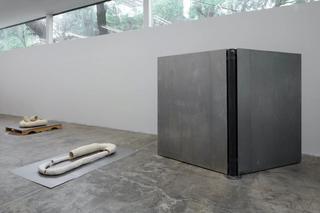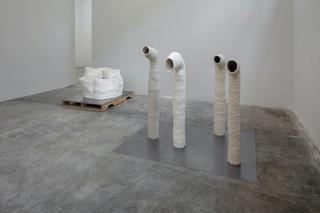Labor Gallery is delighted to present Cortando Linha se Faz Espaço, the first solo exhibition of Raphaela Melsohn in Mexico. This exhibition showcases a body of work that explores the concept of the cut—not merely as a visual element, but as an action that challenges and redefines our understanding of space, materiality, and the socio-political implications of sharing and dividing space.
Raphaela Melsohn is interested in building objects and environments that provoke the relationship between our bodies and the spaces we inhabit. Working with sculptures, prints, installations, and video, among other mediums, Melsohn applies tension on how our bodies occupy space by offering alternatives through contamination, collaboration, and non-hierarchical architectural propositions. She proposes cracks, fluxes, holes, and organic shapes that intend to break the space as it is and reconfigure our bodies as we have normalized them are ways in which the artist politically provokes the instated social and spatial conditions.
Cortando linha… delves into how a line or cut—whether made with a pencil on paper or a coil of clay— serves as an act of presence, a gesture that carves out, divides, and reconfigures space. Cutting implies reconfiguration, revealing the internal dynamics of space much like an open wound exposes the blood struggling to close the cut. The ceramic cracks emerge from a dialogue with the clay, these cuts are not merely imperfections but are shaped by the material's response to its form. Drawing up from Richard Serra’s "Cutting Device”, Melsohn understands the action of cutting as an imposition onto a material. Some ceramic pieces echo Serra’s provocation. Works like "On the Verge of Tipping" and “De novo e de novo passo meus dedos para construir lugar” explore displacement through repetition of an action, or gesture, thus emphasizing the material’s reaction as composition.
Lygia Clark’s "Caminhando", is the continuous cutting of a Möbius strip. The title means "walking" in Portuguese. The "ing" in "walking" indicates an ongoing action, suggesting a perpetual process of division and multiplication. While we often encounter this work through images, these moments capture the endless process of cutting that Clark proposes. Melsohn borrows the continuation of movement as a title for the show; “cortando” is the continuous action of cutting. Similarly, the cut in Clark’s "Bicho" transforms metal into a manipulable form, reshaped by the spectator. Clark described this interaction as a dialogue, between public and artwork, where the cut–resulting in a hinging–acts as a point of stimulation and connection, with no passivity on either side.
In "DANCEFLOOR: a minimalist and neo-concrete heritage" and “Cut” the viewer also faces a choice to exist within the work, making the cut between the object and observer similar to the interaction with Clark’s "Bicho". Cuts can act as connectors, implying segmentation, breakage, and juxtaposition. They can represent a once whole object now fragmented or patched together, with cuts serving as the memory of its division and the evidence of its transformation.
By focusing on cuts, Melsohn's work reveals often overlooked scars—borders, divisions, connections, and the architectural interventions that necessitate a reorganization of our bodies within space. In that respect, Cortando linha is an open invitation to break and make space, to contest the seeming neutrality of our physical and perceptual interaction with our environment.
















